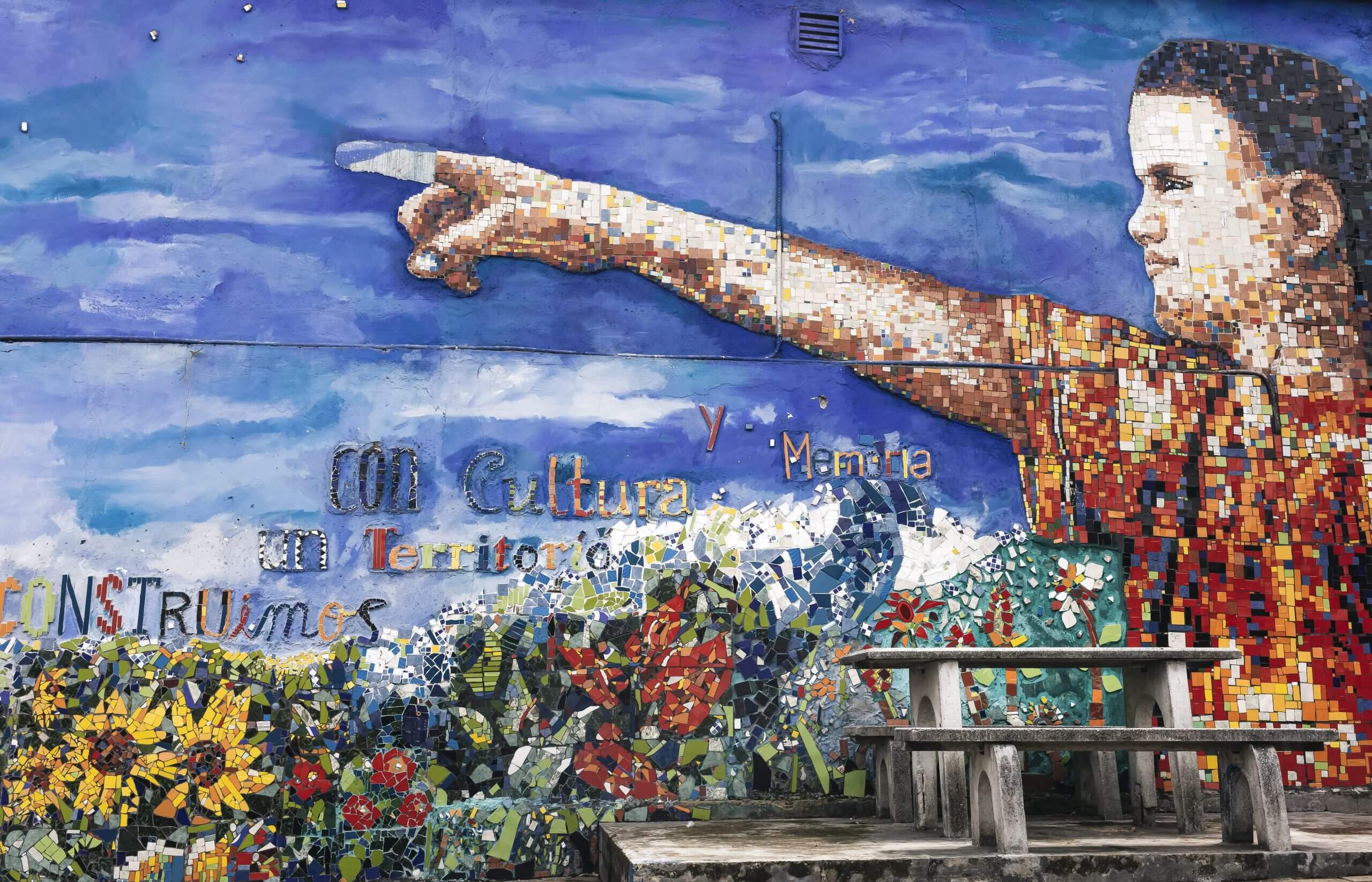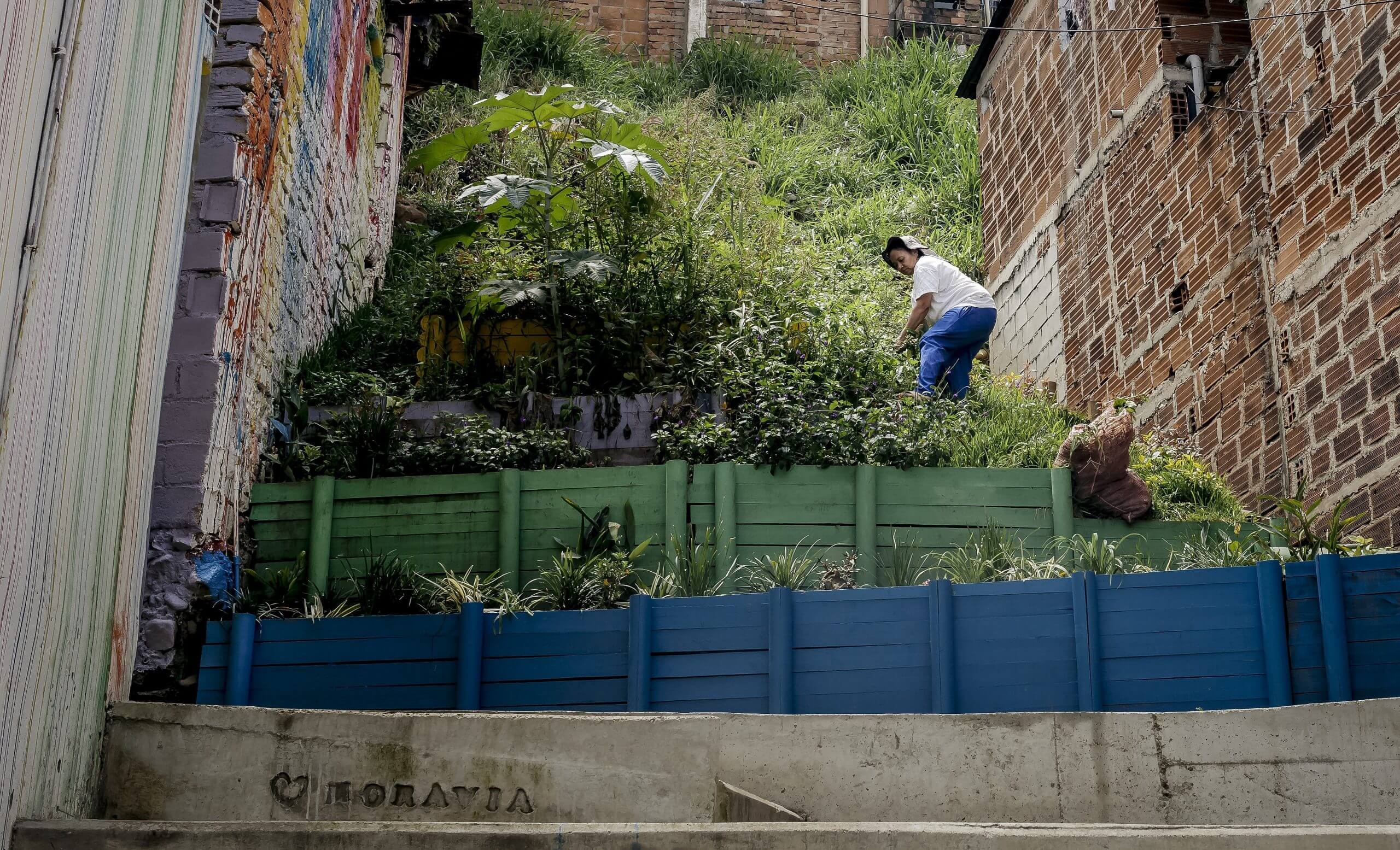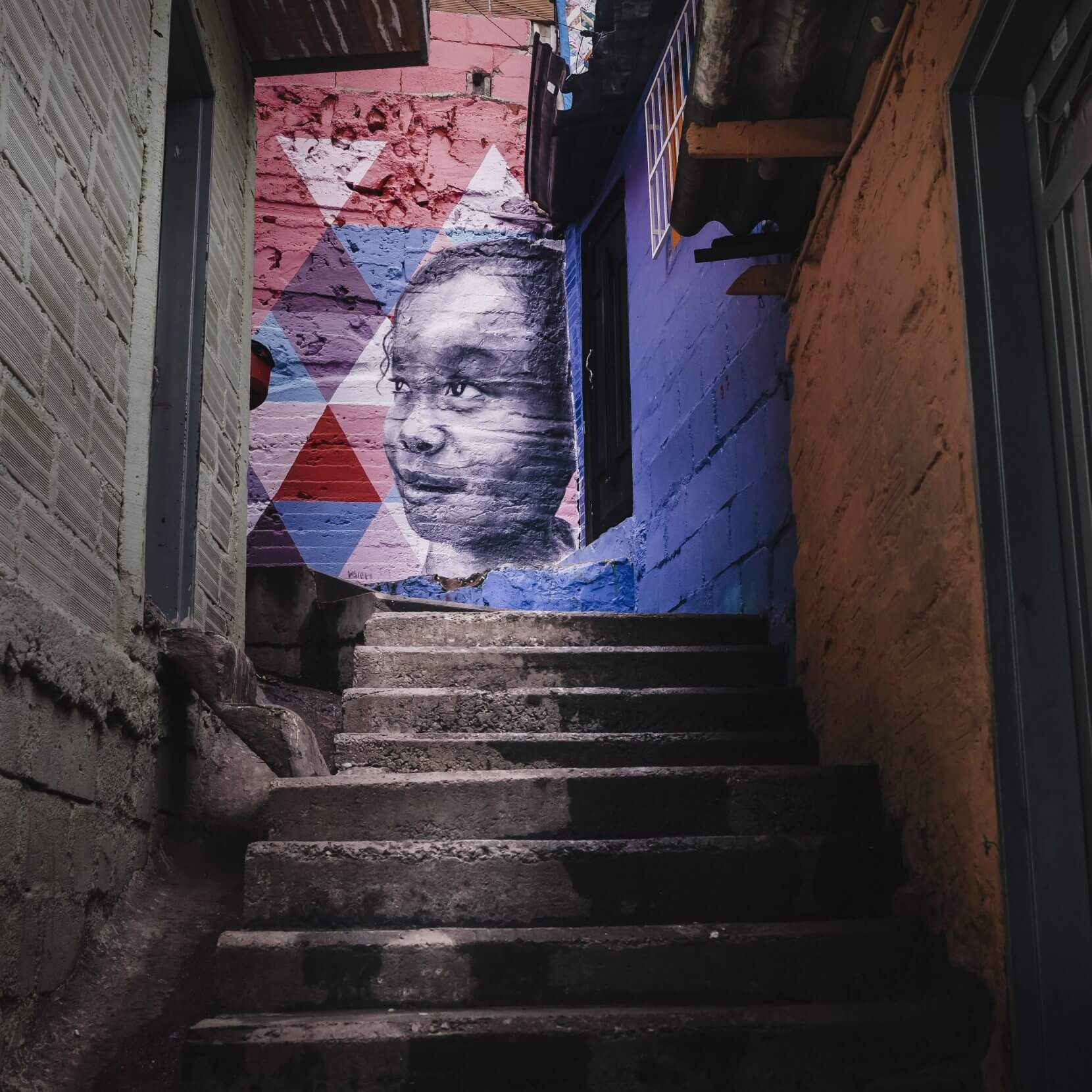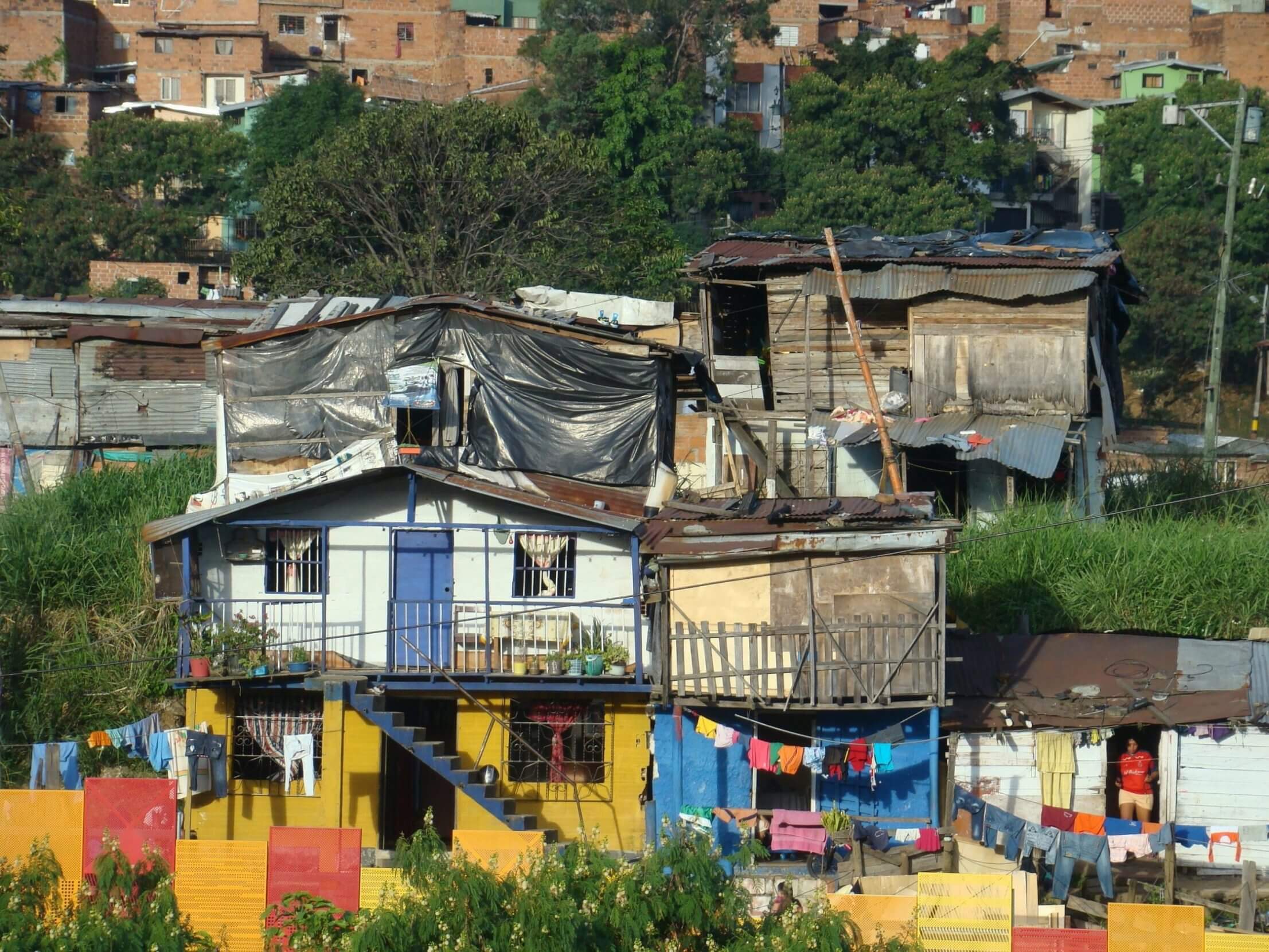My feet slid on stairs made slick by light rain and overgrown grass. I bent and grazed my hand over each cement step to be sure it was really there: The path was too steep and too narrow for me to trust my feet alone. On either side, patchwork gardens of grasses, ferns, and full, leafy bushes rustled gently in the wind. Higher and higher I climbed.
As I crested the hill, I found myself beside a rainbow of orchids, lilies, and hibiscus flowers, which sat in orderly rows in an immaculate greenhouse. Around me, birds of paradise perched on art installations tucked into lush flowerbeds.
I spotted buses far below pulling in and out of Terminal Norte — Medellín, Colombia’s busiest transit station. The chaos of travelers coming from and heading to destinations all over South America seemed serene from this far up, like a sprawl of toy cars moving in seamless choreography. From the Morro de Moravia, the raucous of Medellín is nothing more than a whisper.
Surrounded by verdant plants, art, and quietude, it was hard to imagine that not too long ago, the Morro de Moravia was home to a community in despair, living atop a mountain of putrid garbage and decomposing bodies. It was even harder to imagine that, though the community had been rehabilitated, somewhere below my feet all of that garbage was still there.

PHOTO: JODI CASH.
I was at a party the first time I heard the story of Moravia: Esteban, a middle-aged Colombian man with braces, smiled as he and I parceled through the tale, conferring facts in Spanish and English, each of us trying to demonstrate our grasp of the other’s native language. It was incredible, he told me, that a neighborhood once built on garbage could become what it is today.
“A neighborhood was built on trash — basura?” I asked, not sure that I had understood correctly.
“Sí,” said Esteban, through his metallic grin. “Basura.”
He explained that the community had developed out of desperation during Colombia’s decades-long civil war –– a multi-faceted fight that began in 1964. Drug and cartel-related violence had been rampant then, particularly in Medellín. While the country was being ravaged by economic crisis, militia groups, and guerrillas, many Colombians had sought refuge. They found it, he told me, in Moravia.
And yet, he explained, despite the growing number of inhabitants, the area became the city’s municipal dump in 1977. I thought that might have put an end to the community, but Esteban told me it did the opposite. Instead of repelling people, the massive deposit of trash attracted the extremely impoverished –– basureros who used materials found in the garbage heap to construct ramshackle homes. They sold odds and ends from the pile.
“They even ate food they found in the trash,” Esteban said. “And children fought with birds for scraps.”
But the Moravia of 2017 looked very different, he said. The dumpsite had become a massive garden, worked almost exclusively by women — a concept, he noted, that was still unusual in Colombian culture.
Esteban had described destitution unlike anything I’d ever known — the thought of children fighting with birds for food made my eyes well with tears. But even more powerful was the vision of people transforming their community.
The weight of [the community’s] presence had sent hazardous gases from decomposing waste spewing into the air, the smoke-like plumes making it appear as though the neighborhood was burning.
In the month I’d spent in Medellín, one theme was consistent: The paisas (a name for citizens of Antioquia, the department in which Medellín is located) took incredible pride in their home. Few actions seemed to excite the people of the city like the opportunity to show off real progress — work that existed without the help of politicians. This story of a neighborhood built on a landfill and reformed into a garden run by women sounded like a poignant case of Medellín’s extraordinary resilience.
I had to see it.
~~
“Dónde están las mujeres?” My friend Andres, who was acting as my translator, asked a guard on top of the Morro de Moravia.
We were looking for the women who ran the garden, but they weren’t there. They had not been paid for their work in weeks, and so their presence was sporadic.
At its peak in the 1980s, about 17,000 people lived on top of the dump in fewer than 2,000 homes. The weight of their presence had sent hazardous gases from decomposing waste spewing into the air, the smoke-like plumes making it appear as though the neighborhood was burning.
But even after the city stopped dumping waste on the Morro in 1984, Moravia’s problems didn’t get better. In some ways, they got worse. The neighborhood turned inward. Moravia existed as a makeshift city, which was largely ignored by the rest of Medellín. It became a hub of gang activity and paramilitary violence, with factions warring for territorial control, and its citizens caught in the crossfire.
As the men of Moravia were killed, the women became heads of the households. Change became their legacy.
~~
We snaked past state-of-the-art soccer pitches with uniformed teams running up and down the field, and through alleyways where the chatter of neighbors bounced between open windows and doorways. There were signs for ice cream, and parrots perched on gateways. Twenty-foot-tall murals of the children of Moravia shouted out in pinks, yellows, turquoises, and purples. We were searching for Doña Elsy Torreglosa Gallego –– a beloved leader of Moravia.
When we found her, her hands were buried deep in the dirt, tending to a terraced plot in between two brick apartment buildings with another woman. The women who reinvented Moravia had never been afraid to get their hands dirty.

A woman tends to a terraced garden planted between buildings in Medellín’s Moravia. PHOTO: JODI CASH.
With wild, curly hair and a wide, gap-toothed smirk, Elsy was broad-shouldered, tall and strong. She addressed each person who passed by name and they responded with the reverential title “Doña.” Young men, whose high-spirited banter could be heard from terraced alleyways, would stand up straighter and speak more politely when they saw her. In her company, the people of Moravia treated me and Andres a little differently, too. No longer was our presence greeted by stares. Instead we were greeted with hellos and how-are-yous and kisses on each cheek.
She led us to her home, telling us stories of the German philanthropists and artists who painted the murals of Moravia’s children. She pointed to towering apartment buildings, filled with citizens who now had safe housing. She spoke of her neighbors, like the friend with whom we found her gardening, who had been in Moravia for generations, once on top of the hill and now in one of the first houses built away from the hill –– away from the garbage.

Murals of Moravia’s children coat the walls in vivid colors. A symbol of the future and of hope where it once seemed neither existed. PHOTO: JODI CASH.
In her apartment, the kitchen’s blue walls were water-stained and faded, but the floors were impeccably clean. Patterned linens separated rooms instead of doors. And plastic chairs were stacked next to the table. We were each handed one.
Elsy took her own chair to her daughter’s room, which was just big enough for a double bed and a small TV placed on top of a narrow shelf. There, her teenage daughter waited to straighten her mother’s hair. Elsy was a busy woman and the need for multitasking was absolute. So, she took a seat and we did the same as she began to tell us of a time when coming to Moravia for a visit was unthinkable:
“If someone arrived here alone, immediately they would be grabbed and asked ‘Who are you? What are you doing here?’ And if the person decided to say that they were a state investigator, poof, they would end up in the river, mi hijo,” she said and leaned closer to Andres, pointing a finger toward his face. “That’s why the neighborhood was declared a Red Zone [an area with high guerrilla or paramilitary activity]. And the truth is that it got worse…. [The guerrillas, militias, and, cartel] would kill people in other neighborhoods, and they would come here and throw the bodies here.”
Criminals, Elsy told us, would bring bodies in the backs of trucks, as many as eight bodies, or 10, or even 12, and then toss them over the Madre Laura Bridge on a bend in the road known as the Curva del Diablo — the Devil’s Curve. In this underserved part of the city, who would stop them?
“I saw it. I saw it,” Elsy said.
~~
Sunlit walls were papered with flyers advertising painting classes, dances, guest speakers, recitals, and concerts. They hung next to photographs of the community in its most desperate state, the juxtaposition a source of pride for what the people of Moravia had overcome, rather than shame for what they had once endured. Children laughed and chased one another in and out of doorways and down the halls. The Moravia Cultural Development Center –– a collection of courtyards, galleries, and gathering rooms designed by renowned Colombian architect Rogelio Salmona –– had another name: La Casa de Todos. The House of Everyone.
We walked past the homes that remained on the hill, plastered with defiant slogans on banners, past the photos of Moravia as it once was, and through the gardens with words like “hope” and “love” engraved in the sidewalk. Down below us was a city that had once shunned the people who lived on this hill –– that had written them off as violent, destitute basureros with nothing to contribute to Medellín –– but despite the violence and stigma and environmental degradation, people still came to Moravia.
~~
“There were more weeds, more rats, the armed groups were getting more power and were selling [residential] lots,” Doña Elsy said, scowling. “On that hill, we were stigmatized by all of Medellín: all of us. Because Pablo Escobar used to visit us; because the guerrilla arrived here, because the guerrilla defeated the armed groups.”
Pablo Escobar was a sensitive topic in Medellín. Many in the city refused to speak of the world’s most notorious drug lord who was the cause of thousands of Colombian deaths. But the residents of Moravia had varied opinions on the man who also introduced ideas of civic responsibility that still shape Medellín today. During an era when most of the city turned away from Moravia, he extended a hand, installing lights at local soccer fields and initiating conversations about what citizens deserved.
“The people and I liked him very, very much,” Elsy said. “He was here as if he were at home; he met with the leaders; he brought the project ‘Medellín without slums.’ He was one of the people saying that Medellín shouldn’t have slums, that all of the people, rich and poor, had to have dignified housing.”
But real change in Moravia came after Escobar’s death in 1993.
In the late 1990s, with an unemployment rate around 65%, virtually all of Moravia’s residents lived in poverty in tiny, illegal apartments which were precariously stacked on top of each other.
Though close to downtown Medellin the neighborhood was devastatingly isolated. People couldn’t get jobs and without jobs, they couldn’t move. The cycle persisted.
“It was so sad,” Elsy said, “us being in the center of the city, right here, but without access to anything because we are from Moravia.”
That changed when the city decided to address what was happening in Moravia. Action began, Elsy remembered, with the city’s eviction of nine families that lived atop the trash heap. But the people of Moravia objected; they refused to leave their homes without the promise of a new and brighter future for their neighborhood. In a demonstration of resistance, women and children laid on the ground, blocking entrance to the neighborhood to prevent evictions.
The community proposed a 12-year plan that addressed environmental needs, housing, employment opportunities, education, access to healthcare, and more.
“There had to be room for everyone, everyone,” Elsy said.

A view of Moravia. At one time thousands of people lived in apartments stacked atop one another. The process of rehabilitating the community continues today as more and more families are moved into safer housing. PHOTO: IVAN ERRE JOTA.
For more than five years, Moravia’s leaders negotiated with Medellín’s city government about which goals would be prioritized and how they would be achieved. In 2006, work officially began.
Citizens moved off of the hill into free housing, and city and community leaders began discussing what to do with the trash heap. The mayor’s office wanted to cover the mound with cement, but Moravia’s leaders wanted more.
The solution was a nitrogen-fixing garden that would diminish heavy metals in the soil, restoring vitality, beauty, and a measure of health to a formerly hopeless space. Combined with avenues for community involvement, this was precisely what Moravia’s leaders were after.
“It was social inclusion. It was connected with everything we had wanted,” Elsy said, nodding at Andres and me, as we both listened in awe.
“We in Moravia have learned to be successful women, not women with guns. The age of weapons is over now.”
~~
From atop the Morro de Moravia, I looked down at bustling Medellín. The serene quiet I’d found on the hill was eerie in contrast to how I imagined it once might have been. I struggled to envision the flowerbeds as ramshackle houses, and the gardens with their sidewalks of hope and love as a mountain of trash. I struggled to hear the sounds of children fighting with the birds for scraps of food. And I thought of Elsy and how she and the women of Moravia had led their community out of the darkness, and how their work is not finished.
A legacy of poverty does not disappear overnight and a history of violence cannot be erased by orchids. The age of weapons might be over in Moravia, but it is still beneath our feet as we walk down the steep and slippery stairs.
Jodi Cash
Jodi Cash is a writer and filmmaker from Atlanta living in Paris. She recently premiered her first feature-length documentary, “The Green Flash,” and is now on the hunt for her next big story.



